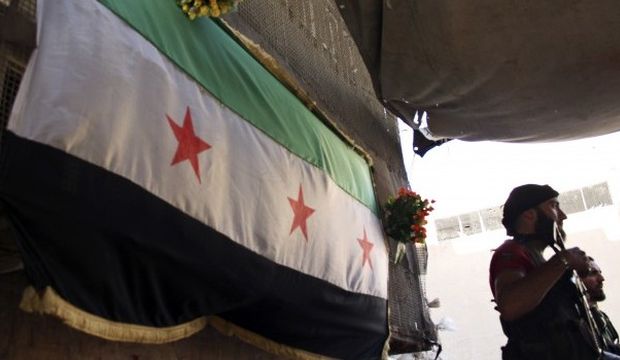The Syrian army is back in the spotlight again. There have been a number of recent Russian and Syrian reports on the army’s battles against the opposition in Syria. In reality, the standing army these reports refer to is actually now made up of a mixture of troops belonging to foreign powers who are carrying out most of the fighting in Syria on behalf of the Syrian regime.
These foreign parties mainly include members of the Lebanese Shi’ite group Hezbollah, the Iraqi militia Asa’ib Ahl Al-Haq, and Iran’s Quds Force. They also include Afghani Shi’ite militias and others who have been recruited and trained to serve the Iranian regime’s agenda in Syria and other conflict zones in the Middle East. This is the “army” which all those recent official Syrian government statements refer to, the “army” the Russians are claiming to support through their intervention in Syria.
Russian Foreign Minister Sergey Lavrov once mocked the Free Syrian Army (FSA), asking if the group had an official address he could write to. He was of course attempting to throw doubt as to whether the FSA actually exists, implying that those fighting Bashar Al-Assad are all terrorists and that everyone who belongs to the opposition is actually affiliated with the Islamic State of Iraq and Syria (ISIS) and Al-Qaeda. Two days ago, the Russian envoy to Saudi Arabia described the Syrian opposition as “fragile.” The Saudis confidently responded by asking Moscow to point to the Syrian army which they claim to be supporting on the ground.
For more than 18 months now, military experts have confirmed that there remains no trace of this army. Most of its soldiers have either been killed or have defected. Those who remain meanwhile have been marginalized because most of them are Sunnis whose loyalty to the regime is thereby questioned. As such, they are drip-fed with meager fuel and ammunition since the regime fears they may defect to the opposing camp.
The Syrian regime has thus filled the vacuum by resorting to volunteer forces—as per the Iraqi style. However, this did not yield any fruitful results as most of these forces have little training and mainly consist of youths from minority groups, such as the Alawite sect to which Assad belongs. In fact many of them have chosen to escape their military service and have fled outside Syria.
Today, the Syrian army, or Assad’s army, mostly comprises forces overseen by Iranian military leader Gen. Qassem Suleimani, who claims that there are some 100,000 fighters in Syria that are defending the Assad regime.
The opposition FSA also includes different parties and factions, but most of them are moderate and patriotic. Although it also includes some religious extremists, they have not been brought from abroad and do not belong to groups like ISIS and the Al-Qaeda-affiliated Al-Nusra Front.
The FSA was mainly born as part of efforts by the Syrian opposition, which comes under the umbrella of the political coalition council that includes all of Syria’s religious and ethnic groupings: Sunnis, Kurds and Christians, as well as minorities such as Alawites, Druze and Turkmen, have all served in leading positions. However, Assad, whom the Russians and the Iranians are defending, no longer represents anyone, not even his small Alawite sect—upon which he inflicted the biggest massacre in their history when he forced their sons to engage in the fighting during the last four horrific years.
You may have Syrian traffic police in Damascus; however there is no such thing as the “Syrian army”—at least not in the sense which the Russians have been using the term. Even their Iranian allies avoid using the term “Syrian army,” as they now consider the Syrian armed forces to be made up of their own fighters.
When the different parties involved in the struggle in Syria—the Gulf states, Turkey, Russia, the United States, and Europe—talk about the future role of the Syrian army and the security forces, they are only referring to symbolic concepts of official state institutions. There are now no more than a few thousand soldiers and a few hundred officers and generals left in the Syrian army, which was once made up of around 250,000 soldiers.
However, it is not only the Syrian army which has disappeared. During the past four years of the war, the structure of the security forces’ institutions and intelligence apparatuses, which were once described as being among the strongest in the world, have been dismantled. As such, Moscow and Tehran must stop trying to paint a false picture regarding what is happening in Syria; the truth is no longer a secret, with all the different groups involved being open regarding this. The reality is that right now in Syria there is no state, no system, no legitimate president, no security forces, and no army.
Above all, the Iranians—and not the Russians—are the biggest winners from Russian involvement in Syria, which is mainly targeting Syrian opposition forces and not terrorists like ISIS as Moscow claims.
The Russians are trying to create a balance by eliminating the armed Syrian national opposition so that the world—especially Turkey and the Gulf states—is forced to support the so-called regime in Damascus in order to fight foreign fighters belonging to ISIS and other terrorist groups. This is the result that will finally serve the interests of Iran, which by then will have seized Iraq, Syria, and Lebanon, next setting its sights on the Gulf states.
